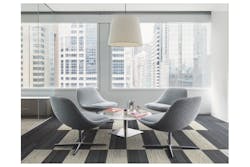When we think about safety during the pandemic, and beyond, it is important to think about it in two components—physical and emotional safety. Our physical safety adaptations are everywhere around us, including masks, visual social distancing cues and more.
Emotional, or psychological, safety works in tandem with the physical changes. By making noticeable and concerted changes with safety in mind, people experience heightened emotional security, which helps mitigate stress and discomfort.
Today, as a large-scale return to the workplace becomes more promising with the current prioritization of vaccine distribution, the design community is once again focused on quickly adjusting our workplaces with health, wellbeing and long-term design strategies in mind.
A best practice is quickly emerging for the office of the future: using resiliency as a model.
What is Designing for Resiliency?
The definition of resiliency is adapting to change effectively. Similarly, a resilient space prioritizes flexibility and adaptability to make short-term adjustments that can eventually be modified to meet changing needs.
For example, the coronavirus pandemic resulted in the need for social distancing. To quickly adapt, some addressed this safety need with arrows, signage and lines meant to guide the flow of users within the space, most often in the form of stickers that can be rearranged and removed as needed.
When we design for resiliency, we think about innovative ways to design built spaces that can be easily transitioned into a “safety mode.” This may mean strategically using design elements—color, texture, pattern and format—to offer subtle physical distancing reminders for today and after the pandemic has passed. This creates safe, stylish spaces, without bearing the constant reminder of difficult times.
Resilient spaces are also flexible and adaptable. This ensures any immediate design needs can be easy, quick and low-cost, allowing for active changes to address safety and functionality needs. And, while flexibility should support short-term needs, adaptable spaces have the capacity to accommodate substantial change over the lifetime of a building in response to social, economic and physical surroundings. Adaptability responds to the ever-changing needs of building occupants.
[Related: Short- and Mid-Term Solutions for Reopening Offices - Part 1]
All in all, resilient spaces consider the present and the future—they can shift based on internal and external factors. Planning for resiliency is a matter of establishing where an organization is in the present moment and then building from its unique culture, budget and vision.
How can we begin to adapt our workspaces with resiliency at the core? The answer is modular design.
How Modular Design Contributes to Resiliency
Nature is inherently resilient and can be an inspiration for modular systems. As a strong tree may adapt to its surrounding environment by bending and flexing when weathering a storm, modular design accounts for future opportunities to adapt, rather than bracing for impact.
Modularity allows for updates to be made and easily changed as design trends and the needs of a particular space evolve.
An example during COVID-19 is changing out modular flooring tiles to denote proper distancing measures, an extension of wayfinding, which can be changed back as needed to address space concerns—contributing to both flexibility and adaptability.
With modular design strategies, the office of the future can remain just that—a space that is inherently able to flex to future needs and trends—whatever they may be.
It is increasingly critical to understand the role materials play in the success of a space. The right materials bring value to the users of space, positively contributing to their health, productivity and experience.
[Related: Wallcoverings Industry Responds to Pandemic with Performance Materials and Enhanced Cleanability]
Flooring is a highly influential plane in architecture as it is the only surface we are held to by gravity. When considering the flooring, it is important to opt for products that exist as functional design tools because they can create meaning and mood. For example, carpet tile brings textiles within the space, creating visual interest while also providing warmth, comfort underfoot and acoustical benefits.
Similarly, the flexibility of modular flooring lends itself to the suggestion of pathways, transitions, zones and traffic flow. For a bilateral corridor, flooring allows you to suggest movement or create separation through lines, banding, color and pattern. In pain points, like entryways and lobby spaces, patterns can be arranged to signify traffic, waiting spaces and more.
Modular flooring is especially beneficial in that it’s easy to swap out tiles as needed to modify designs within the space according to specific needs and design trends.
Contributing to the Employee Experience with Design
When we design our workplaces with resiliency in mind, we place the experience of its users at the core of decisions, which impacts business success. Carefully designed workspaces contribute to employee happiness, productivity and wellbeing. It is important to approach each space with the desired experience in mind.
For spaces delineated for focus, it’s important to select materials that optimize acoustics and user comfort. Collaboration areas might opt for materials that create a sense of energy through pattern and color.
No matter the given space or its intended use, it is critical to prioritize employee wellbeing. During the current COVID-19 pandemic, this has never been truer.
Interface recently underwent a redesign of its global headquarters, dubbed Base Camp by employees, in response to the increased need for physical and emotional safety and wellbeing. In addition, it took this opportunity to examine how the space was being used to ensure the work environment supported employee needs.
Notably, and like most other companies, Interface did not go into 2020 expecting to overhaul its office’s design, meaning it had little resources to make changes. However, when Base Camp initially opened in the fall of 2018, the space was designed with resiliency in mind. The building was intended to serve as a community gathering place and a showcase for innovation, which allowed Interface to make updates centered around evolving employee needs and wellbeing, company culture and future objectives for the space. Most notably, one of the key objectives was bringing people together again, which employees revealed would be a key driver in returning to the office.
Resilient Design and Sustainability
A lesson can be learned from the trials of the coronavirus pandemic as another global crisis calls for urgent change within the building and construction industry—climate change.
There is too much carbon dioxide in the atmosphere, which is contributing to global warming. As human activity releases more of it, the natural world is struggling to keep up.
It is critical that the industry takes a cue from nature and views carbon as a resource, rather than the enemy, using it as a building block to engineer better, more resilient products. At the same time, as companies set out to redesign office spaces, it’s important to opt for building materials that aim to reverse global warming by reducing the carbon emissions associated with their full product lifecycle.
By selecting healthy building materials and products, companies can further bolster their efforts to promote the wellbeing of their people, especially as we recognize the direct impact of climate change on health.
Want more strategies? Download this eHandbook: Strategies for Reopening Offices Post-COVID-19
About the Author:
With a passion for design and learning, Mindy O’Gara blends both of these talents into her daily role as director of Product and Learning Experience at Interface. She educates both internal and external audiences on Interface’s product offering and its contribution to design. At the junction between neuroscience and design, O'Gara demonstrates the significant role of material choice and its effects on how we experience three-dimensional space.
About the Author

firstName lastName
i+s partners with design practitioners and other industry experts to deliver informative and engaging content on a variety of topics related to commercial interior design, from the latest trends, research and technology to innovative projects, products and educational CEUs. Interested in becoming a contributor? Contact us today!
